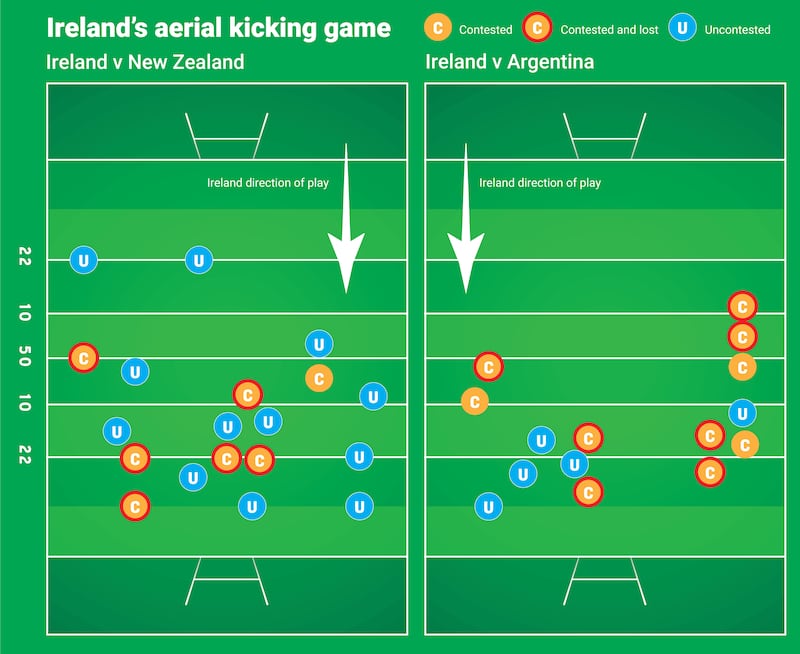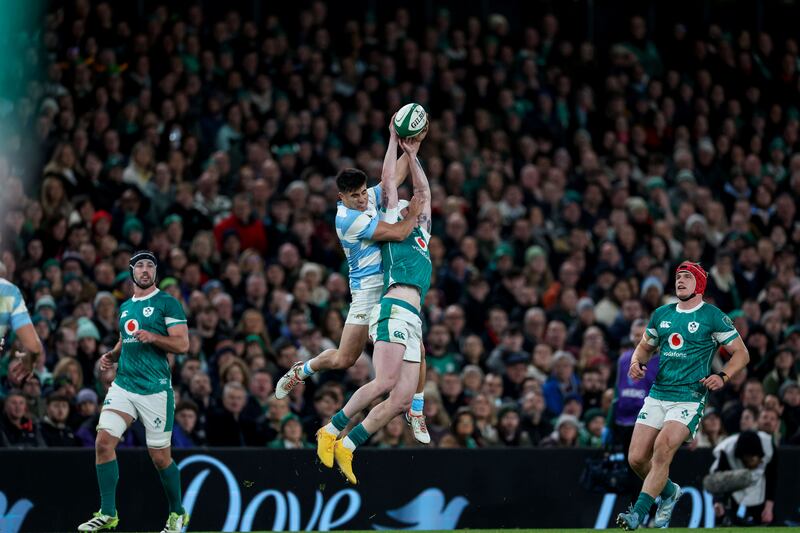World Rugby’s decision to tweak the ground rules concerning aerial duels may not have the desired or anticipated benefits or positivity because of safety issues. The derring-do of two players leaping high in the air to contest possession, while aesthetically pleasing, could quickly become derring-don’t if they fail to land back on their feet unscathed.
Penalising “escorting or blocking” is at face value a good thing in that it stops the kick chaser from having to pinball between opponents as he makes his way to the landing zone, but it now provides for two players contesting a high ball to arrive and jump at high speed into a mid-air collision. There can only be a modicum of control even with the most genuine intent on both sides to contest the ball fairly.
Ireland fullback Hugo Keenan and New Zealand wing Caleb Clarke provided a classic illustration in the recent Test match, contesting fairly, but returning to terra firma with a thud. It’s also another collision point in rugby where officials are asked to interpret intent. The hope is that players can adapt technically. Maybe watch a few Rob Kearney clips?
On a tangential note, Ireland’s aerial work in the first two Tests of the autumn series is definitely a work-on to use a colloquial rugby phrase. In the defeat to New Zealand, the bald statistic is that Andy Farrell’s side lost all seven aerial duels that were contested. A little context is required. Ireland’s kick-off/restart game was predicated on sending Keenan chasing and while it didn’t bear fruit that night it would seven days later.
RM Block
Ireland outhalf Jack Crowley got pretty good hang time but the idea to kick predominantly to the 6ft 5in All Blacks centre Jordie Barrett wasn’t likely to be fruitful, or any directed towards fullback Will Jordan.
Mack Hansen was another who would have a much more positive impact the following Friday night against Argentina. In the New Zealand defeat, the Irish right wing chased with purpose but despite twice getting his fingertips to the ball first wasn’t able to regather; the first from Ciarán Frawley’s cross-field kick and the second, from the replacement outhalf’s dink over the New Zealand defence.
Ireland did get two penalties from 11 uncontested kicks, both for blocking. The first followed Jamison Gibson-Park’s Garryowen and the second of which, on James Lowe, was the jumping-off point for Ireland’s try.

By way of contrast the All Blacks kicked the ball in the air on 12 occasions, six uncontested in which Ireland gained possession and six contested in which they fared marginally better than their hosts by “winning” two duels. Those came from a penalty against Gibson-Park for blocking and an Irish knock-on, when Frawley was hustled by New Zealand wing Mark Tele’a.
Ireland refined their kicking plan against Argentina, using it as a gambit a little less often but contesting aerially to a greater extent. Keenan and Hansen were superb in that capacity while Lowe managed a clever turnover when he chased a restart and managed to be the first of a triumvirate of Irish players to corrupt a New Zealand maul and hold up the catcher.
There was greater focus and accuracy to the home side’s kick-chase game even when things went awry. Hansen won the first aerial contest from an Irish perspective, but Tadhg Beirne knocked on as he tried to snap up the loose ball.
The Connacht wing ensured that his team regained possession when tapping back a nicely weighted Crowley Garryowen into the waiting hands of Keenan and soon after it was the Irish fullback who demonstrated his airborne skills when timing and technique combined to win a restart. Ireland won two of the nine occasions they were instigators of kicking to reclaim the ball.

Felipe Contepomi’s Argentina gave Ireland free ball just three times, and one of those was in kicking off the second half. They contested kicks on 10 occasions, winning back the ball exactly 50 per cent of the time. Again, a little context here, as their hosts knocked on under pressure on three of those five wins. The most eye-catching Argentinian success was winning a goal line drop on their 22.
Ireland finished on the right side of five Pumas kicks, Crowley and Lowe winning soft contests, while Hansen got up superbly for one clean catch and a tap down to his buddy, Keenan. This weekend Farrell’s side will road test that aerial game against Fiji and it’ll be instructive whether they go about it when measured against the All Blacks (18) and Argentina (14) games.
There are nuances, too, in when to kick, something upon which Farrell touched when he noted the fact that Ireland overplayed the ball at times in keeping possession in both matches and also whether the team is forced into putting boot to ball rather than employing it as a proactive tool such as a cross-kick, chip, Garryowen or grubber with the expectation rather than hope of getting the ball back.
It’s how it fits into Ireland’s attacking structure that will be revealed in greater depth over the remaining matches in the Autumn Nations Series.
- Sign up for push alerts and have the best news, analysis and comment delivered directly to your phone
- Join The Irish Times on WhatsApp and stay up to date
- Listen to our Inside Politics podcast for the best political chat and analysis





















